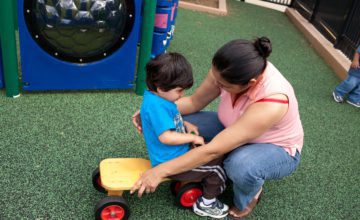What It’s Like for You
Six-month-olds are so much fun—energetic, engaged and full of smiles. You may find your baby is a magnet for kind and well-meaning, but intrusive, strangers who are eager to get your baby’s attention. As Sarita, mother of Kyle (6 months) explains:
I’ll never forget, it was December—in the middle of cold and flu season—and we were in the mall to see all the holiday decorations. These two women came up to us and started talking to Kyle and then touching his cheeks and face. I couldn’t believe it. I didn’t know what to say, and ended up doing nothing. But I really wish I could have come up with a nice way to say buzz off!
Every parent is going to feel different about strangers who are talking with and even touching their babies. Some parents will be okay with it, while others will feel like Sarita did. As a parent, it’s your call to decide what level of interaction (if any) is okay or not for your baby. What works to sidestep “touchers”? A simple, and firm: Please don’t touch my baby’s face. But he loves it when you talk to him.Know that it’s not your job to make the other adults feel comfortable. It’s your job to make your baby feel safe and secure.
What It’s Like for Baby
I love this warm, giant puddle that Nana is letting me play in. She keeps calling it the “bath”. It is so fun to be center stage with my grandma with nobody to interrupt us! She always laughs when I splash my boat. And I love when she sings to me as I’m playing. I drop my fish into the water and love seeing it go under. When Nana washes me with a soapy cloth, she tells me all about my body: My belly, my feet, my hands, my head, ears and nose. When we’re all done, she wraps me in my warm, fuzzy towel and cuddles me close. She tells me how much she loves me and kisses me right on the nose. Hmmm, I must be somebody pretty special!
What Your Baby is Learning:
Social-Emotional Skills:
- The pleasure of spending time with adults other than his parents. This lets him know that he is part of a larger loving community that includes grandparents and others.
- Confidence and positive self-esteem when his Nana kisses him and tells him she loves him
- Relationship-building skills when he interacts with his Nana in such positive and loving ways
- Self-regulation as he manages his excitement during this playtime with Nana
Language and Thinking Skills:
- Language, when he hears his grandmother sing and talk with him Words for parts of the body when his grandmother labels these as she washes him
- Rules of social interaction—that conversation is a “back-and-forth” process in which each person has a turn to talk and interact
- Sensory information, like wet/dry, heavy/light, or slippery/rough
- Visual observations, like noting which toy sinks and which toy floats
- Spatial relations—or where his body is in space and in relation to other people and objects.
Physical Skills:
- Body awareness—understanding that his body is his and separate from others.
- Coordination, as he puts together several actions—leaning, reaching and grasping—in order to get an object.

What to Expect From Your Baby’s Development
As you review the chart, keep in mind that development is not a race and that every child grows at her own pace and in her own way. Your child may develop skills faster or slower than indicated below and still be on track. If you have questions or concerns, talk with your child’s health care provider or other trusted professional.
Your Toddler’s Development From 6 to 9 Months
| What Your Baby Can Do | What You Can Do to Connect With Your Baby |
|---|---|
I am learning to think and solve problems. |
|
|
|
I can control my body. |
|
|
|
When I’m closer to 9 months, I start to understand that people and things are still there even when I can’t see them. |
|
|
|
I am working hard to communicate with you. |
|
|
|
I may start to be afraid of people I don’t know. |
|
|
|
My personality is starting to show. |
|
|
|
Did you know…
That your 6-month-old knows who’s nice and who’s naughty? In a small study of 12 six-month-olds, babies sat on their parents’ laps and watched a puppet show where one wooden toy was trying to climb a hill. This toy was either pushed down the hill by an unhelpful character (a second toy) or pushed up the hill by a helpful character (a third toy). After the show, babies were presented with the helpful toy and unhelpful toy and asked to pick one. All 12 babies chose the helpful toy.
What the Research Means for You
Your baby is already watching the world around her carefully and trying to make sense of what she sees. She can even tell the difference between positive and negative interactions. That’s pretty amazing. So fill her world with a community of positive and loving adult caregivers. And, as she grows, find regular opportunities for her to spend time and build healthy relationships with peers. This will nurture the strong social skills she’ll need to establish lifelong friendships.
Spotlight on: Getting Baby to Sleep
Most healthy 6-month-olds are capable of sleeping through the night. They are able to take in enough milk and other food during the day that they do not need to eat during the night. However, many babies are still waking up because they are used to falling asleep while being fed, rocked, or comforted in some other way. When they wake up—which we all do several times a night—they don’t know how to get themselves back to sleep on their own. If you’d like to learn more about helping your baby learn to sleep through the night, check out the tips below.
Keep it routine. Bedtime routines help babies learn when it’s time to go to sleep. They prepare children, physically and emotionally, to settle down. Having a bedtime routine means doing the same thing—as much as possible—every time you put your baby down to sleep. Families will have different routines to calm and soothe babies before bedtime based on their culture and the needs of their individual child. Some families may give their baby a bath, then read a story, then put the baby in the crib. Another family might massage their baby with lotion while singing her a lullaby, then put her in bed with them. (To read about ways to safely co-sleep with your baby, click here.) It doesn’t really matter what your bedtime routine is. What’s most important is that the routine stays basically the same from day to day, and that it is comforting, loving, and relaxing for your baby.
Turn off the TV. Watching television together doesn’t generally work well as a bedtime routine. The goal of the bedtime routine is to help children relax and get ready for bed. Television shows are often noisy and stimulating and may even make children feel more awake.
Read the signs. Watch for the ways your baby lets you know he is tired. Yawning is the most obvious hint, but there are others, too. Your baby may have a certain sleepy cry, or he may pull on his ear, rub his eyes, or be fussy. When you see these signs, slow things down and start your bedtime routine.
Making the shift from awake-and-active to relaxed-and-asleep actually takes a fair bit of effort on your baby’s part. This is why bedtime routines are helpful. They help babies slow down. So when you see signs that your baby is sleepy, don’t wait to start bedtime. After babies get a second wind, it can be even harder for them to go to sleep because they are overstimulated. (Just think how hard it is for you to fall asleep when you are “wired” or stressed over something.) When your baby is overtired, he will need more help from you than usual to calm down and fall asleep.
Choose bedtime practices that support your sleep goals. Families have different goals when it comes to their babies and sleep. For example, parents who want their children to sleep through the night often put their babies down while they are sleepy but still awake, so they learn how to fall asleep on their own. Other families may rock or stroke their baby’s head until she drops off to dreamland. It’s important to keep in mind that when you feed, rock, or rub your baby’s back until she falls asleep, she learns to rely on you to help her get to sleep, be it at bedtime or in the middle of the night. When you put your baby down while she’s still awake, she learns to soothe herself and put herself to sleep. There’s no right or wrong way to put your baby to sleep. Your bedtime approach depends on your beliefs, values, and goals around sleep.
Temperament influences bedtime. Your baby’s intensity—whether he is easygoing or, on the other hand, has a very strong reaction to things—plays a part in how easily he is able to learn to fall asleep on her own. Babies with different temperaments develop “self-soothing” skills at different rates.
The more reactive your baby is, the more challenging it may be for him to soothe himself. He does not have the same ability to manage strong feelings and sensations, as compared to less reactive babies. These babies often need more help to be calmed. You can watch your baby for signs that he is learning how to calm herself. For example, how does he cope with the minor stresses of day-to-day life, such as transitions from playtime to mealtime. How does he react to a diaper change, or waiting for the breast or bottle when he’s hungry? Is your baby able to calm himself and wait, for example, by sucking on a hand or finger? Does he use other self-soothing techniques—like looking away and closing his eyes when he is overstimulated? How much help does he need to calm down when upset? Does it take just a few minutes or a lot longer?
Babies who have developed effective ways of coping with relatively minor stresses are often better able to fall asleep on their own. If your baby is still struggling with these skills, you are not alone! Learning self-control and self-soothing skills is no small task and takes time.
Plan for protests. As your child learns to fall asleep on her own, she may cry or protest. This is extremely common, since it is a big change for her. So it’s important to have a plan for how to respond when she cries out for you (which naturally can be very distressing). For example, you might want to peek your head in every few minutes to assure her you are still there. Or you may decide not to go in at all after you put her down (unless, of course, you think something is wrong). Some parents choose this approach because going in and out can excite the baby and even increase her protests. Thinking through these issues before they happen, talking about them with your partner, and deciding together how you want to respond can help you feel more prepared and better able to follow through on your plan.
Patience, patience. Even though it may seem overwhelming at times, your baby will learn to adapt to whatever sleep approach you’ve decided is right for your family. However, it takes time, patience, and consistency. Time and patience are needed if you are teaching your baby how to soothe himself and fall asleep without support from you. Consistency is important because it helps children learn what to expect. If you change your response from night to night, it is confusing and makes it harder for your baby to adapt. When you are consistent in what you do at bedtime and nap time, you help your baby learn new bedtime skills more quickly and easily.
Babies are people, too. There are situations and events that can impact a baby or child’s sleep pattern, such as a new sibling, a new caregiver, starting child care, etc. Life events like these can create or make sleep problems worse. If your child was sleeping just fine and then started having problems, think about what has been going on in his life recently. Sleep disruptions can be a symptom of something that is causing your child stress or worry, or may even signal a new developmental stage, like teething or crawling.
Let’s Play: Activities That Nurture Bonding and Learning
Popsicle Stick Puppets
Cut photos of babies, dogs, cats, and other animals from magazines or catalogs. Glue each photo to sturdy cardstock or cardboard, and glue a popsicle stick to the back of each photo. Hold these “puppets” up to show your baby, make them move and dance as you tell stories or sing. (For example, match animal puppets with a few rounds of Old MacDonald.) Is your baby interested in holding one of the stick puppets?
“Teeny Tug-of-War”
Prop your baby, with a bolster or pillow, into a sitting up position. Sitting up builds muscle strength in your baby’s back and trunk that will help him learn to crawl and walk later on. As your baby sits, hand him the end of a washcloth to hold. You hold the other end. Swing the washcloth or gently pull on it as you sing (to Row row row your boat): Tug, Tug, Tug the rope, Swing it back and forth, Together we will tug so hard, and then we’ll play some more!
What’s on Your Mind?
1. I hear so much about the importance of reading to your baby. But my 6-month-old only seems interested in eating the book. Any suggestions?
There has been a lot of attention recently on the importance of reading and the critical role it plays in helping a child succeed in school. Clearly you are actively promoting these skills by introducing your 6-month-old to the joy of books. She, in turn, is showing you how much she likes them: by chewing and mouthing their pages.
Babies explore the world through their senses—using their eyes, hands, and mouths. Mouthing is not only normal, it’s one of the first and most useful ways that babies gather information about the shape, size, and texture of the objects in their world. Books, with their bright colors and flapping pages, are especially fascinating, so your daughter is doing all she can to learn more about these funny and delightful square things.
Some parents wonder why it is important to read to a baby who is not even using words yet. But it is actually in these early months and years that the foundation for talking and reading is being built. As you read to your child, she is learning to tune into the sounds of her home language and is becoming familiar with the rhythm of speech. And hearing words over and over helps her eventually learn their meaning.
Reading also nurtures a love of and interest in books. The goal at this age is for book exploration to be a pleasurable and positive experience that makes your child eager to keep interacting with and learning about books. So go ahead and give your child chunky board books or soft cloth books that she can safely explore and chew on. Offering these kinds of books will limit your having to say “No,” or having to take the book away, which can lead to negative feelings about books. Until she is a little older and can safely handle paper pages, you may want to keep that treasured copy of Goodnight, Moon out of reach.
2. We’re planning to leave our 6-month-old with a babysitter for the first time while we attend an evening wedding. I’m worried because my daughter doesn’t do very well with new people. How can we prepare her?
You’ve already taken the most important step by tuning in to the fact that your daughter is slow-to-warm-up to new people. Plus, it is common for babies this age to cling because they are beginning to understand the difference between the people they know and those they don’t.
If possible, invite your babysitter to come over and spend time with your child, while you are there, before the wedding. Feeling comfortable with this new person in her life can be very helpful and ease the transition. This gives your daughter a chance to get to know the sitter in the safety of your presence. It will also give you a chance to talk about how you care for your daughter, including the way she likes to be held and fed, what upsets her, and how to soothe her.
On the night you’re going out, ask the sitter to come to your house about a half hour before you plan to leave to give your daughter time to feel more comfortable with her. When the sitter arrives, sit down with her and your baby for a few minutes and get involved in an activity, such as playing with toys or looking at a favorite book. That way, when you leave, your daughter and the sitter will already be engaged.
When you head out the door, it’s important that you say good-bye. Avoid the temptation to sneak out. While she may still cry at your departure, saying good-bye tells your child she can count on you to let her know what’s going on, and that she doesn’t have to worry that you’re going to disappear without warning. Say your good-bye with a cheerful tone, smiles, and warm hugs. If you have a worried look on your face and a quivering voice, the message you are sending is that you don’t feel good about leaving her and that there is something to worry about. If you’re concerned about how your daughter is doing, call the caregiver a little while after you leave to check in.
3. I’m the mother of a 6-month-old and my mother just passed away. I’m devastated by the loss and as a result, have very little energy for my baby and don’t play and interact with him like I used to. Of course I do the basics—feed, change, and dress him, but I feel like I’m just going through the motions. I don’t know what to do. I’m worried about how this will affect his development.
Losing a parent is hard at any time, but losing a mother when you have just become a parent yourself can be particularly painful. What you are experiencing—loss of energy and interest, lack of pleasure in what was once joyful to you—are very normal symptoms of grief. Your inability to interact with your child in a way that once came so easily is common.
What a challenging time this must be for you. You are a child, mourning and missing your mother. At the same time you are a parent who is responsible for taking care of the needs and feelings of a young child. The fact that in the midst of your suffering you are able to think about your child is very important because it opens the door to finding ways to meet both your need and your baby’s needs.
Your concern about your child’s development is valid. At this age, children are building their attachments to people. These early relationships lay the foundation for developing healthy, positive attachments in the future. Babies are sensitive to what’s going on around them, especially to their mother’s moods and to any changes in their world. Your baby is likely experiencing his own loss as you are not the Mommy he has known, the Mommy who used to play and laugh with him a lot. This can lead to babies feeling sad themselves and becoming more irritable, clingy, and demanding.
Research shows that what matters most to the baby over the long run is how long the mother’s grief reaction or depression lasts. During this period, you will be sad and it is normal and necessary to mourn. So it is important for both you (and therefore your baby) to get the support you need to cope with and work through this terrible loss. For most, it is too much to go through on one’s own, which is why it is very important that you seek professional help. There are grief counselors specially trained to help. You can contact your local mental health agency for referrals or talk with your health care provider. Also, check your newspaper for support groups for women who are coping with loss. They can be useful as well. Talking with friends and family is important and can be helpful, too, but it does not replace professional help.
To make sure your son’s needs are met during this time, ask your husband or partner to help out more. Ask a family member or a babysitter to come in a few times a week to care for and play with your son and to give you a break. Do one or two activities with your son that require less energy, for example, reading or taking walks together. And try to see your time with your son as an opportunity to keep your mother’s spirit alive. Do you have special memories of singing a particular song or reading a book with your mother? Did your family have any cherished family traditions, like pancakes every Sunday? Think about introducing these into your family’s daily routines and rituals. You may even find some comfort in repeating these loved traditions from childhood with your own baby.
This is a very difficult time. It is important that you continue to think about and take care of yourself and your baby, and ask for the support of friends, family, and trusted professionals.
Expert Reviewers
- Terrie Rose, PhD, President and Founder, Baby’s Space
- Ross Thompson, PhD, Professor of Psychology, University of California at Davis
- Robert Weigand, MS, IMH-E, Director, Child Development Laboratory, Arizona State University
This ZERO TO THREE newsletter series was made possible by generous funding from the MetLife Foundation.






